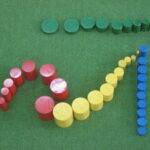Conflict resolution in preschool can be a challenge. The desire for peace in the classroom is universal. Despite the best of intentions, conflicts arise. Issues with sharing, taking turns, invading personal space, and other ways of disrespecting each other can be common. Having the knowledge to equip children with good conflict resolution skills is essential in providing a peaceful and productive learning environment.
A good way to resolve conflicts in preschool is by using “The Peace Rug. The Peace Rug is a great conflict resolution concept commonly found in Montessori schools. Maria Montessori was a strong advocate for peace and recognized its importance in the classroom. Children who learn to take responsibility for their own actions and respect others will develop the skills necessary for getting along with one another in the future.
The concept of being heard is so important to resolving a conflict. The Peace Rug is based upon this idea. It’s so easy to just walk away in the middle of a conflict. This solves nothing other than making the other person involved even angrier. The Peace Rug allows both children involved in the dispute to be heard in a peaceful and safe setting.
Using The Peace Rug in your school or home is very simple. The materials needed are a small rug, a “peace item” such as a plastic or silk flower, a plastic dove, or a peace rock, and a basket to put the items in. Roll up the rug and place it in the basket with the piece item. Place the basket on a shelf where the children can access it easily.
Here is an example of how the Peace Rug should be used when a conflict arises: John threw Sara’s marker across the room causing Sara to cry. The teacher may need to intervene at this point and walk John and Sara over to the basket of peace items to set up the Peace Rug. The rug is unrolled on the floor and the flower (or other item) is placed in the middle. John sits at one end of the rug and Sara sits at the other. One child will get to hold the flower and speak first while the other listens. Since Sara is so upset, she may get to talk first. She holds the flower and says, “John threw my marker across the room and I didn’t like it. It made me really sad.” John then takes the flower and says, “Sara told me my picture was ugly. That made me mad so I threw her marker.” They can take turns holding the flower and talking until both sides are heard. It may take some prompting or help from the teacher to talk about what happened and the feelings involved.
Usually a short discussion prompted by the teacher will follow regarding more peaceful ways to solve the problem. The children will focus on using their words in a positive way when they’re angry instead of acting out in anger. If a child involved in the conflict was hurt, it may take some prompting for the other child to ask, “Are you okay? Do you need some ice or a drink of water?” The child can then go with the teacher to get an ice cube in a bag or a cup of water to help take care of the child who’s hurt. In this way children learn to take care of one another in the classroom and take responsibility for their actions.
The Peace Rug method is best introduced at the beginning of the school year. Usage should be modeling and taught through role-playing by the teachers. The Peace Rug can be used for most any dispute. It can also be used for a group of children. Teacher involvement and prompting may be necessary with very young children. Older children can and will resolve disputes using this method on their own. Sometimes it takes much more than merely saying, “I’m sorry.” to resolve a dispute. The Peace Rug can also easily be used at home or in a classroom with older children.
It’s amazing how quickly children get over their disputes, go back to what they were doing previously, and go back to being friends after using the Peace Rug. Conflict resolution skills are learned through positive communication, listening to, respecting, and caring for one another. This technique quickly becomes a great way to foster peace in the classroom.
Source:
Montessori, Maria; “The Absorbent Mind“; 1949

